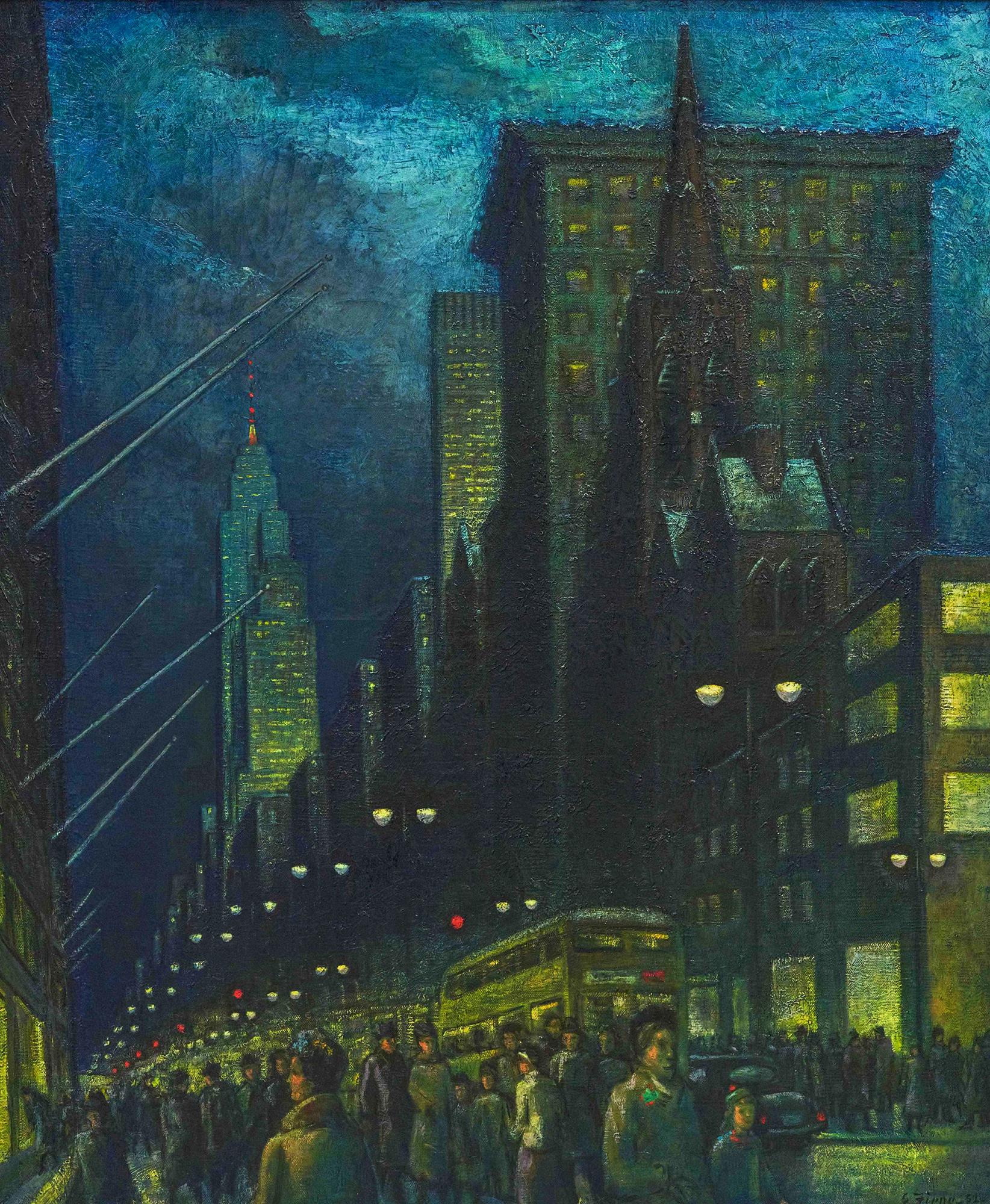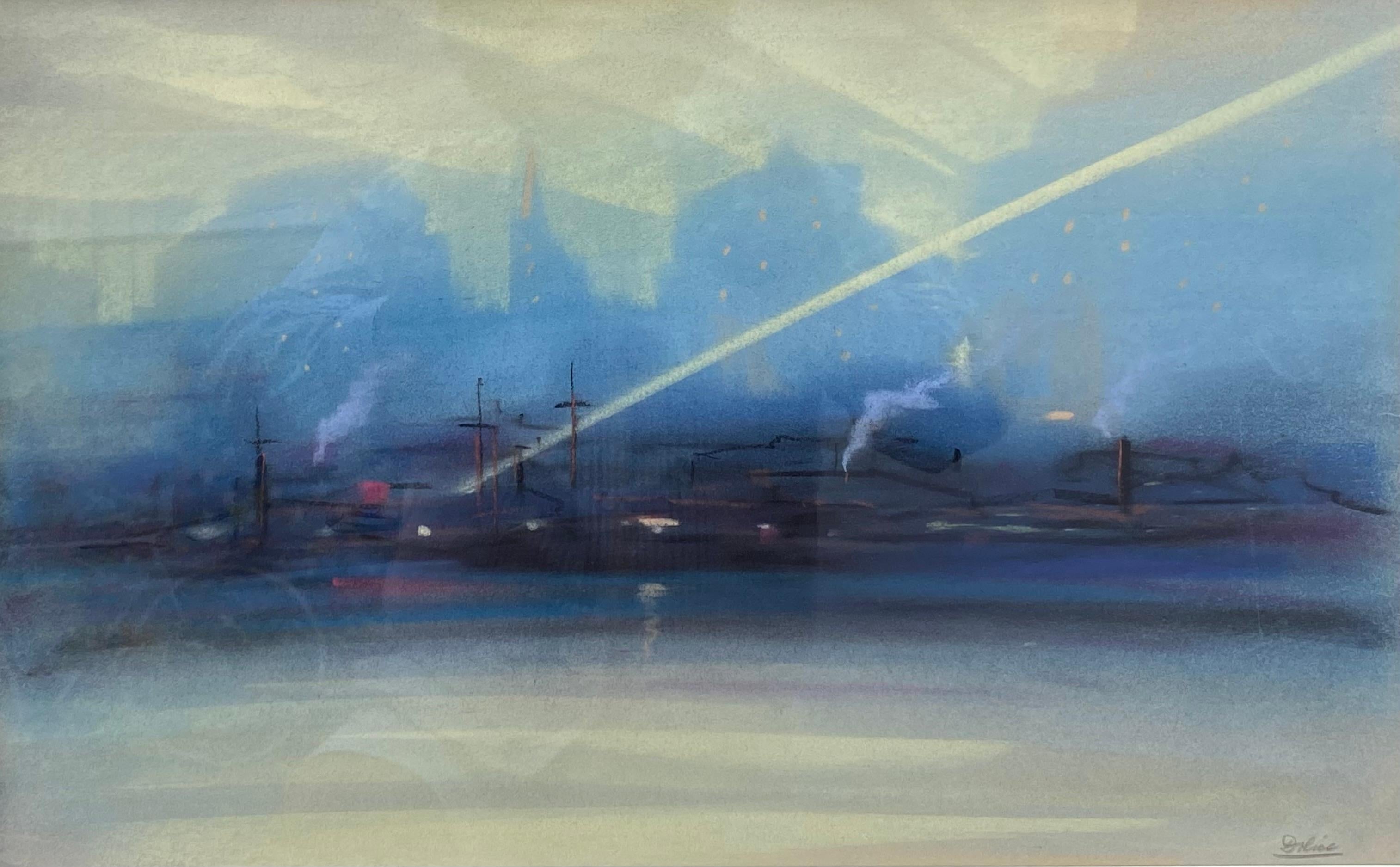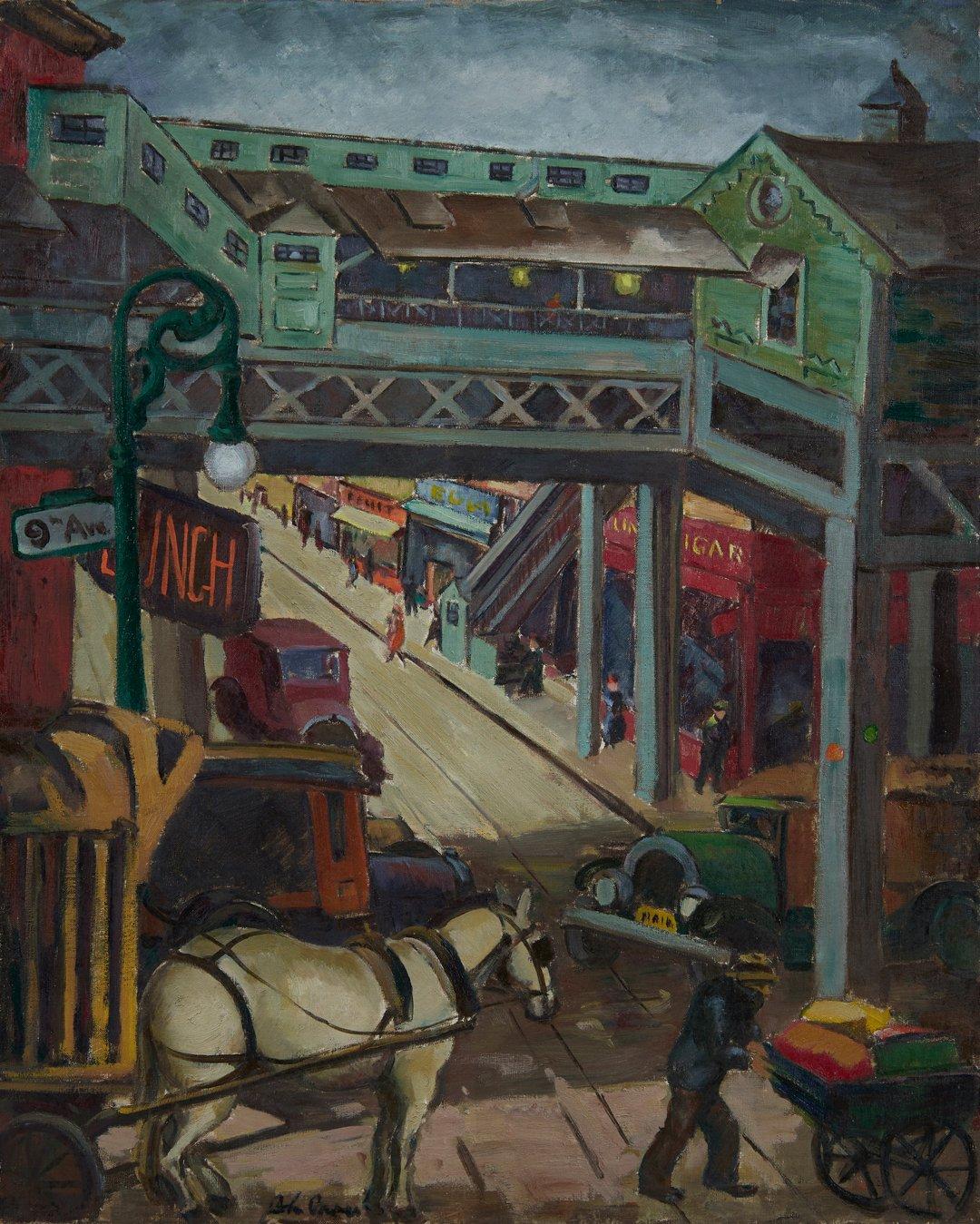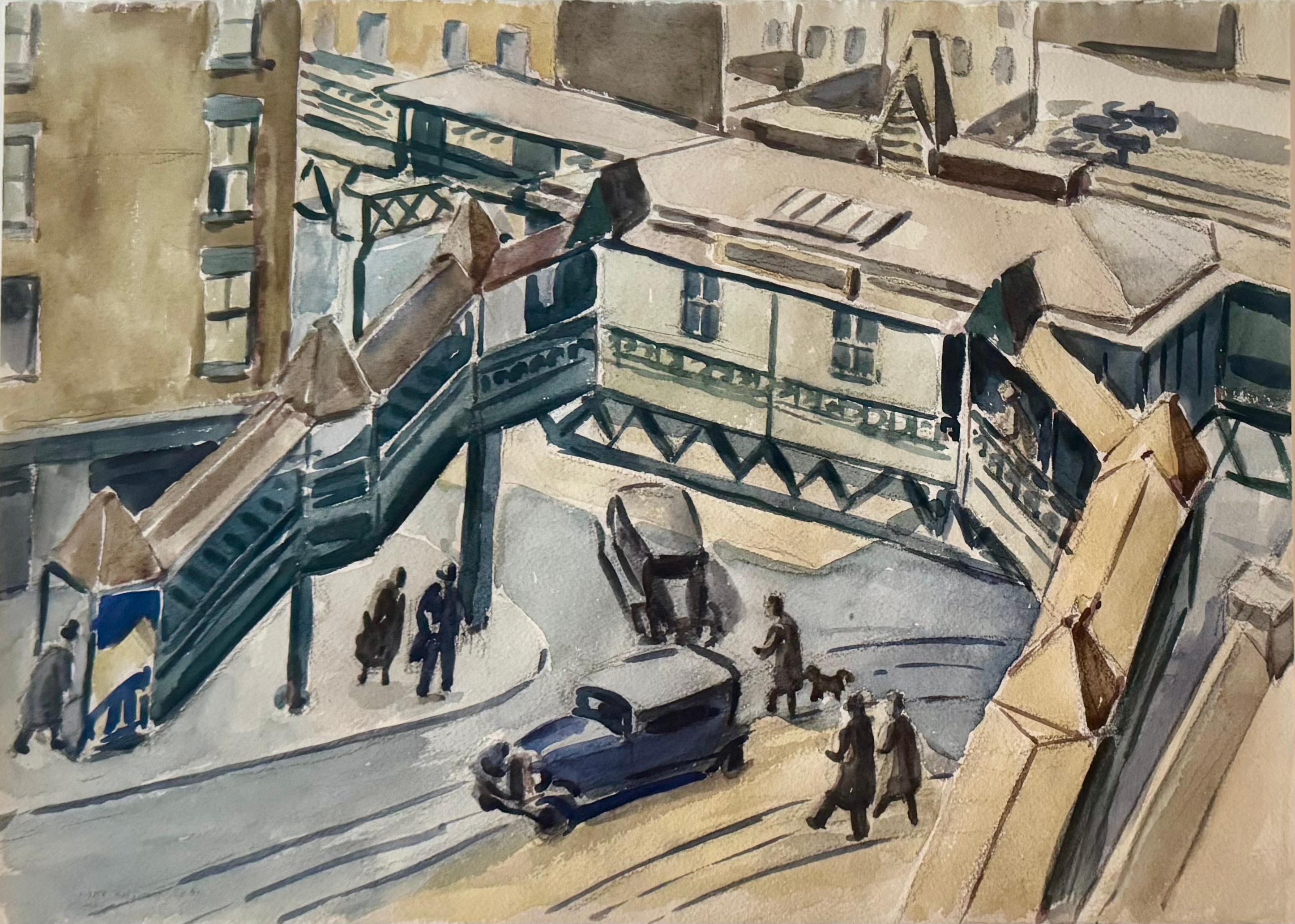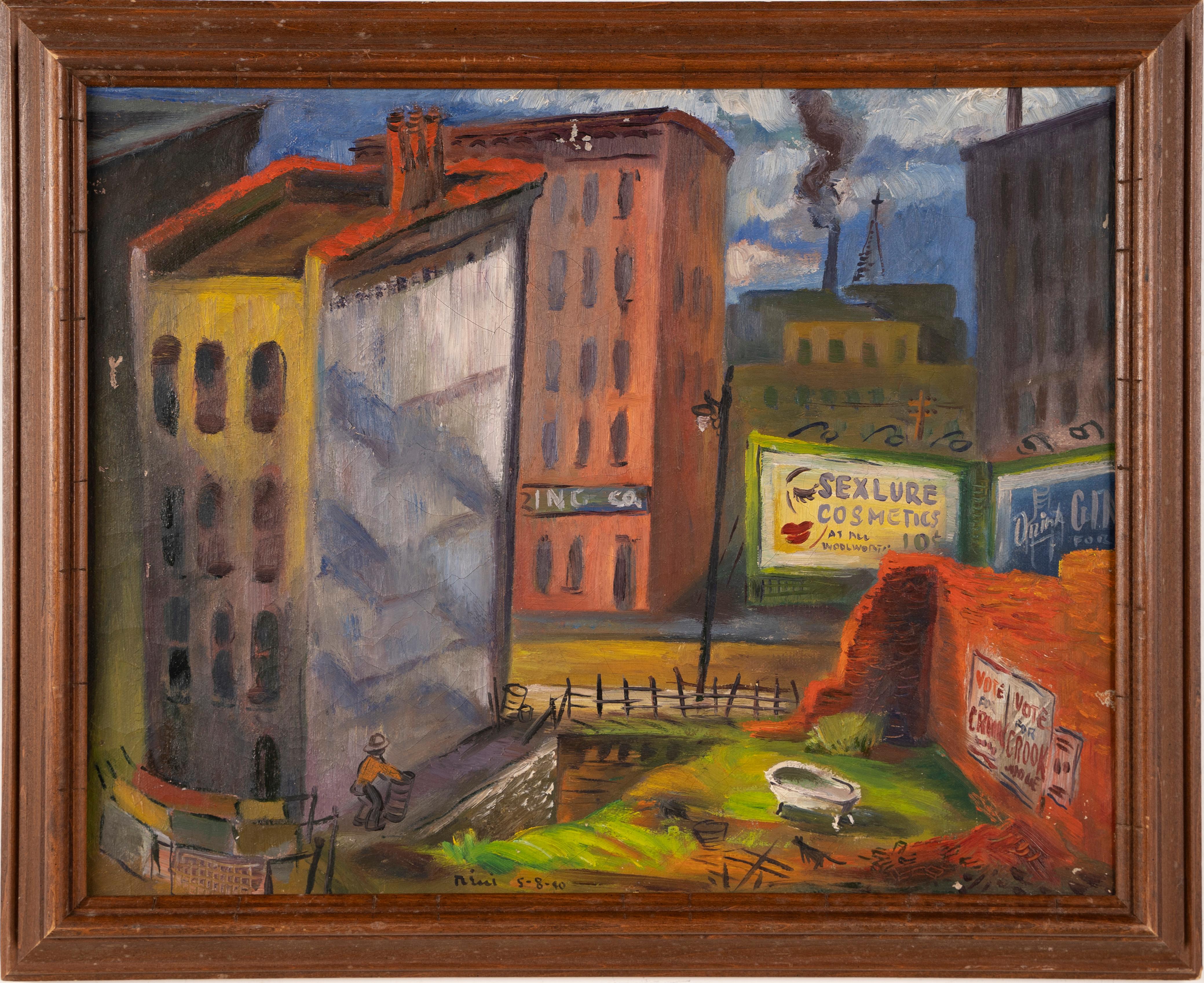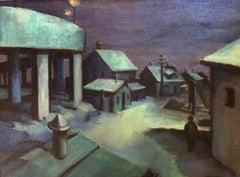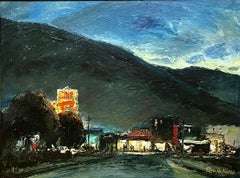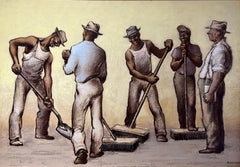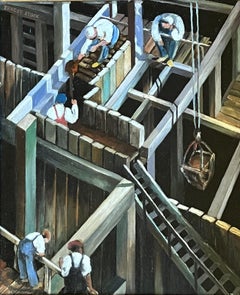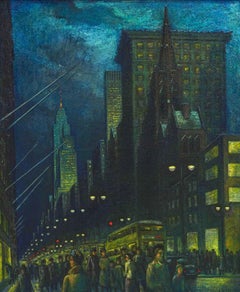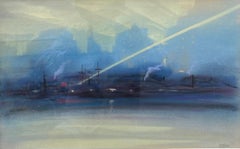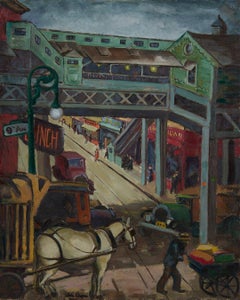Items Similar to Road Repairing, Lower Manhattan at Night
Want more images or videos?
Request additional images or videos from the seller
1 of 5
Margit VargaRoad Repairing, Lower Manhattan at Night1934
1934
$8,500
£6,385.44
€7,363.45
CA$11,794.86
A$13,106.69
CHF 6,868.04
MX$160,730.19
NOK 87,597.91
SEK 82,408.90
DKK 54,957.65
Shipping
Retrieving quote...The 1stDibs Promise:
Authenticity Guarantee,
Money-Back Guarantee,
24-Hour Cancellation
About the Item
Road Repairing, Lower Manhattan at Night, 1934, oil on Masonite, signed and dated lower right, 24 x 16 inches; original label verso has title and address
Margit Varga was an artist, gallerist, art editor and author, who mainly worked in New York. Born in Hungary to a well-to-do-family, Varga immigrated to the United States as a young girl.* Although she initially found New York to be drab and lifeless compared to Budapest, she discovered creative freedom in painting and drawing. Varga studied art at the National Academy of Design, Columbia University, and the Art Students League with Boardman Robinson and Robert Laurent. She founded and operated the Painters and Sculptors Gallery in Greenwich Village in the early 1930s, a venue designed to highlight American art. News of the opening of the gallery was widely published across the United States. During the 1930s and 1940s, she exhibited often, including at the Salons of America, Society of Independent Artists, Rhode Island School of Design Museum, Brooklyn Museum, Cranbrook Academy of Art, Golden Gate International Exhibition, Dallas Museum of Art, Dayton Art Institute, Virginia Museum of Fine Art, Corcoran Gallery, Whitney Museum of American Art, Art Institute of Chicago, Pennsylvania Academy of Fine Arts, and Cincinnati Art Museum. She was represented by New York’s Midtown Galleries and was a member of the National Association of Women Artists. She was honored with a solo exhibition at the University of Nebraska and the Philadelphia Art Alliance. When reviewing this exhibition, the art critic for The Philadelphia Inquirer commented favorably about the artist’s New York paintings such as Road Repairing, Lower Manhattan at Night, “Margit Varga’s oils, now in the larger of the two galleries on the first floor of the Art Alliance, reveal that not too frequent ability to take familiar, seemingly commonplace city sights and transform them by imaginative magic into pictures which enchant the eye and cause those of casual minds to wonder why they too did not discover a bit of all this beauty.” From 1936 through the mid-1950s, she worked as Art Editor for Life Magazine. Varga was Life’s Assistant Art Director from 1956 to 1960 and art consultant from 1960 to 1970 for Time, Inc. She co-authored the seminal and well-reviewed volume Modern American Painting in 1939 and Waldo Pierce in 1941, as well as contributing to Studio Publications. Her work is represented in the collections of many American museums, including the Metropolitan Museum of Art, the Whitney Museum of American Art, and the Pennsylvania Academy of Fine Arts. Varga is listed in Who Was Who in American Art and other standard references.
*NB: some sources indicate Varga was born in the United States in the upper east side of Manhattan.
- Creator:Margit Varga (1908 - 2005, American)
- Creation Year:1934
- Dimensions:Height: 24 in (60.96 cm)Width: 16 in (40.64 cm)
- Medium:
- Movement & Style:
- Period:
- Condition:
- Gallery Location:Los Angeles, CA
- Reference Number:1stDibs: LU1859216267652
About the Seller
5.0
Vetted Professional Seller
Every seller passes strict standards for authenticity and reliability
1stDibs seller since 2022
15 sales on 1stDibs
Typical response time: 11 hours
- ShippingRetrieving quote...Shipping from: Los Angeles, CA
- Return Policy
Authenticity Guarantee
In the unlikely event there’s an issue with an item’s authenticity, contact us within 1 year for a full refund. DetailsMoney-Back Guarantee
If your item is not as described, is damaged in transit, or does not arrive, contact us within 7 days for a full refund. Details24-Hour Cancellation
You have a 24-hour grace period in which to reconsider your purchase, with no questions asked.Vetted Professional Sellers
Our world-class sellers must adhere to strict standards for service and quality, maintaining the integrity of our listings.Price-Match Guarantee
If you find that a seller listed the same item for a lower price elsewhere, we’ll match it.Trusted Global Delivery
Our best-in-class carrier network provides specialized shipping options worldwide, including custom delivery.More From This Seller
View AllMoonlight Shanties
Located in Los Angeles, CA
Moonlight Shanties, c. 1940s, oil on canvas, 24 x 18 inches, signed lower right, signed and titled verso
About the Painting
In Moonlight Shanties, Joachim depicts a lower-class neighborhood sitting along-side an elevated road or railway which crowds out the small nearby houses and structures. Joachim’s use of an expressionist palette and gestural brushstrokes together with the isolated figures obscured in the shadows, create a feeling of unease, isolation and even loneliness. From the 1920s through 1940s, American artists commonly employed expressionist conventions in their social realist works which portrayed the gritty side of urban America, especially the communities of the city-dwelling poor. Expressionist styles were considered appropriate for bridging the gap between the modernist idea of art-for-art’s-sake and the narrative qualities demanded by the dual crises of the Great Depression and World War II. Moonlight Shanties successfully uses these expressionist methods to portray a neighborhood and its people who appear to be literally and figuratively “on the edge.”
About the Artist
Paul Lamar Joachim...
Category
1940s American Modern Landscape Paintings
Materials
Oil
A Valley Streetscape at Night
Located in Los Angeles, CA
This work is part of our exhibition - American Coast to Coast: Artists of the 1940s
A Valley Streetscape at Night, 1948, oil on masonite, signed and dated lower right, 18 x 24 inches; literature: King, Chloe, The Paintings of Edgard O. Kiechle – Unearthed After 60 Years, Ventura Blvd, January/February, 2023, pp. 46 – 53 (illustrated)
Edgar Kiechle...
Category
1940s American Modern Paintings
Materials
Masonite, Oil
Street Cleaners
Located in Los Angeles, CA
This painting is part of our exhibition America Coast to Coast: Artists of the 1930s
Street Cleaners, c. 1940s, oil on canvas, signed lower right, 28 ¾ x 42 inches, Gallery Z...
Category
1940s American Modern Figurative Paintings
Materials
Oil
Subway Construction
Located in Los Angeles, CA
This painting is part of our exhibition American Coast to Coast: Artists of the 1930s
Subway Construction, c. 1928, oil on board, 19 x 15 ¾ inches, signed upper left, artist and title verso; exhibited: 1) 12th Annual Exhibition of the Society of Independent Artists, The Waldorf Astoria, New York NY, from March 9 to April 1, 1928, no. 864 (original price $250) (see Death Prevailing Theme of Artists in Weird Exhibits, The Gazette (Montreal, Quebec, Canada), March 8, 1928); 2) Boston Tercentenary Exhibition Fine Arts and Crafts Exhibition, Horticultural Hall, Boston MA, July, 1930, no. 108 (honorable mention - noted verso); 3) 38th Annual Exhibition of American Art, Cincinnati Art Museum, Cincinnati, OH, June, 1931 (see Alexander, Mary, The Week in Art Circles, The Cincinnati Enquirer, June 7, 1931); and 4) National Art Week Exhibition [Group Show], Montross Gallery, New York, New York, December, 1940 (see Devree, Howard, Brief Comment on Some Recently Opened Exhibitions in the Galleries, The New York Times, December 1, 1940)
About the Painting
Ernest Stock’s Subway Construction depicts the excavation of New York’s 8th Avenue line, which was the first completed section of the city-operated Independent Subway System (IND). The groundbreaking ceremony was in 1925, but the line did not open until 1932, placing Stock’s painting in the middle of the construction effort. The 8th Avenue line was primarily constructed using the “cut and cover” method in which the streets above the line were dug up, infrastructure was built from the surface level down, the resulting holes were filled, and the streets reconstructed. While many artists of the 1920s were fascinated with the upward thrust of New York’s exploding skyline as architects and developers sought to erect ever higher buildings, Stock turned his attention to the engineering marvels which were taking place below ground. In Subway Construction, Stock depicts workers removing the earth beneath the street and building scaffolding and other support structures to allow concrete to be poured. Light and shadow fall across the x-shaped grid pattern formed by the wooden beams and planks. It is no surprise that critics reviewing the painting commented on Stock’s use of an “interesting pattern” to form a painting that is “clever and well designed.”
About the Artist
Ernest Richard Stock was an award-winning painter, print maker, muralist, and commercial artist. He was born in Bristol, England and was educated at the prestigious Bristol Grammar School. During World War I, Stock joined the British Royal Air Flying Corps in Canada and served in France as a pilot where he was wounded. After the war, he immigrated to the United States and joined the firm of Mack, Jenny, and Tyler, where he further honed his architectural and decorative painting skills. During the 1920s, Stock often traveled back and forth between the US and Europe. He was twice married, including to the American author, Katherine Anne Porter. Starting in the mid-1920s, Stock began to exhibit his artwork professionally, including at London’s Beaux Arts Gallery, the Society of Independent Artists, the Salons of America, the Cincinnati Art Museum, the Whitney Studio and various locations in the Northeast. Critics often praised the strong design sensibility in Stock’s paintings. Stock was a commercial illustrator for a handful of published books and during World War II, he worked in the Stratford Connecticut...
Category
1920s American Modern Figurative Paintings
Materials
Oil
Jefferson Market Library (Courthouse)
Located in Los Angeles, CA
This painting is part of our exhibition America Coast to Coast: Artists of the 1930s
Jefferson Market Library (Courthouse), c. 1930s, oil on canvas, 30 x 24 inches, signed lower right; presented in a newer silver painted frame
About the Painting
Writing about an exhibition of Charles W. Adams’ work at the Eighth Street Art Gallery in the mid-1930s, Emily Grenauer observed in The World-Telegram that the artist’s paintings were “distinguished for their solid form, well organized design and sumptuous color” and the art critic for The Herald Tribune found Adam’s work “a strong, formal realization of his subject . . . he paints with vital emphasis on structure and composition.” Although we do not know which works these critics referenced, it is likely they were writing about paintings like Jefferson Market Library (Courthouse). With its carefully designed reality, strong angles, solid forms, and well-disciplined puffs of smoke in the background, Adams presents a highly structured version of the Greenwich Village landmark, the Jefferson Market Library, which was a courthouse at the time Adams completed this work. The Jefferson Market Library was a prized subject for downtown painters, including the Ashcan School painter, John Sloan, the modernist, Stuart Davis, and the precisionist, Francis Criss...
Category
1930s American Modern Landscape Paintings
Materials
Oil
Broadway
By Jean Dominique van Caulaert
Located in Los Angeles, CA
Broadway (?), 1952, oil on Masonite, signed and dated lower left, 15 x 18 inches, inscription verso may say "Broadway", presented in its original frame
Jean Dominique van Caulaert w...
Category
1950s Impressionist Landscape Paintings
Materials
Canvas, Oil
You May Also Like
Winter Evening Fifth Avenue - New York at Night
By Ernest Fiene
Located in Miami, FL
Ernest Fiene depicts Fifth Avenue looking down from 57th Street with an unobstructed view of the Empire State Building. The absence of newer glass and steel architecture gives the painting the charm of old New York. The artist captures a dark, moody blue sky as light bounces back from the clouds. This contrasts with the somewhat haunting yellow glow given to pedestrians and street traffic. The people have somewhat of a zombie quality akin to George Tooker. Best viewed with a top and direct gallery light...
Category
1950s Post-Impressionist Landscape Paintings
Materials
Canvas, Oil
Winter Evening Fifth Avenue - New York at Night - Mid-Century.
By Ernest Fiene
Located in Miami, FL
Mid-century New York City is represented as a moment in time. The artist populates his scene with isolated figures that are more shapes of people as opposed to specific individuals....
Category
1950s Post-Impressionist Landscape Paintings
Materials
Canvas, Oil
“New York at Night”
By Leon Dolice
Located in Southampton, NY
Very well executed original pastel on archival paper of New York City at night with beacon by the well known American artist, Leon Dolice. Signed lower right. Circa 1930. Condition is excellent. Beautifully gallery framed with stained mahogany wood frame. Under glass. Overall framed measurements are 21 by 30 inches. Birham Wood Galleries, East Hampton, New York provenance. Exhibited artwork. See photo gallery labels verso.
Leon Dolice was born in Vienna, Austria on August 14, 1892, the son of a machinest/welder. He went on to study art in Europe and viewing the works of the Masters. Dolice immigrated to the United States in 1920, finding a retreat in the European Bohemianism of Greenwich Village, he picked the streets of this landmark neighborhood as his first subjects. Concentrating on etching and with the encouragement of new found friends and artists such as George Luks and Herb Roth, he soon ventured out and devoted all his time to chronicling the architecture, back streets, dock scenes and other nostalgia that was fast disappearing from the face of Manhattan, mainly in copperplate etchings. A favorite subject for him was the Third Avenue El near one of his New York City studios on Third Avenue. He won accolades for his work, and although he traveled the East Coast recording landmarks in other cities including Washington DC, Baltimore, Chicago and Philadelphia, he always returned to his new home Manhattan.
A decline in popular favor for etchings led him to put aside his plates in the late 1930s and devote some ten years to pastels, linocuts and painting. His subject matter was almost exclusively New York City street scenes, but figurative works, country scenes, and even experiments with Abstract Expressionism at the height of its new found favor in the 1940s punctuated his career.
In 1953, after learning of the forthcoming demise of the Third Avenue El, in the shadow of which he had maintained his studio for over a decade, he once again took to his plates and press and created a final series of Third Avenue and or other New York City landmarks that were then threatened with extinction. His work brings to light aspects of nostalgic New York that survives today only in small part, whether in architecture or in spirit.
Dolice's works are in a number of notable museums and private collections, including the Museum of the City of New York; The New York Public Library Print Collection; The New York Historical Society; Georgetown University Lauinger Library; The Print Club of Philadelphia and others. In the past few years, his work has been exhibited at Hofstra Museum, Long Island, NY; with the Montauk...
Category
1930s American Modern Landscape Drawings and Watercolors
Materials
Oil Pastel, Archival Paper
Ninth Avenue El (New York City), Mid 20th Century Cityscape Oil painting
By John Opper
Located in Beachwood, OH
John Opper (American, 1908-1994)
Ninth Avenue El (New York City), c. 1935
Oil on canvas
Signed lower left and verso
30.125 x 24 inches
The Ninth Avenue El was the first elevated rai...
Category
1930s American Modern Figurative Paintings
Materials
Oil
6th Avenue El at 8th St NYC Cityscape American Scene Social Realism Mid-Century
By Max Arthur Cohn
Located in New York, NY
6th Avenue El at 8th St NYC Cityscape American Scene Social Realism Mid-Century
Max Arthur Cohn (1903-1998)
6th Avenue El at 8th Street
13 x 18 inches
Watercolor on paper, c. 1930
...
Category
1930s American Modern Figurative Drawings and Watercolors
Materials
Paper, Watercolor
Antique American Modernist New York City Street Scene Abstract Oil Painting
Located in Buffalo, NY
Antique American modernist signed original oil painting. Oil on canvas, circa 1930. Signed illegibly. Image size 20L x 16H. Housed in a period giltwood frame.
Category
1920s Modern Landscape Paintings
Materials
Canvas, Oil
$796 Sale Price
20% Off
More Ways To Browse
Alliance Vintage
Vintage Cranbrook
Vargas Original
Vintage Vargas Girls
Vargas Girls
Stark Robert
Susan George
Vintage Winter Landscapes
Golden Gate Park
Oak Tree Oil Painting
Painting Of Mosque
Paris Eiffel Tower Painting
Vintage Cowboy On Horse
Vintage Horse And Carriage Painting
Cape Dutch
Cortes Oil
Horace Brown
Indonesian Landscape
